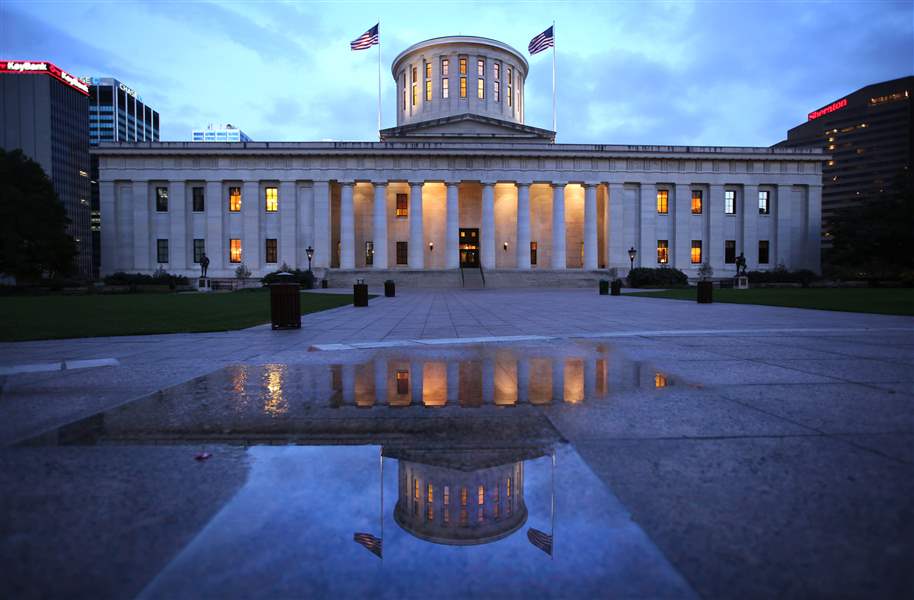
Two events clarify November elections
8/9/2018
The Ohio Statehouse
Columbus Dispatch
Two political events happened this week that help clarify politics in the state of Ohio.
One is the special election in which two candidates battled to a draw in a heavily Republican congressional district, which should send worries through the Republican ranks.
The other is a ruling from the Ohio Supreme Court that sided with the Ohio Department of Education in its crackdown on the Electronic Classroom of Tomorrow.
The special election in the 12th Congressional District this week gave Ohio residents something they haven’t seen for a long time in this state — a close contest in an election for the U.S. House of Representatives.
Republican state Sen. Troy Balderson (Zanesville) clings to a 1 percent lead in the election over Democrat Danny O’Connor, the Franklin County recorder in the vote count from Tuesday.
Although the voting is over, the vote-counting is not. Mr. Balderson has a 1,564-vote margin in the unofficial count, but there are still nearly 8,500 absentee and provisional ballots to count.
Mr. O’Connor is not conceding because if he wins 60 percent of the outstanding votes then he wins the election. The votes will be counted in a week.
Regardless, the fact that he came within less than a percentage point proves that Republicans were either caught flat-footed in the special election, outorganized, outcampaigned, and outspent by the Democrats, or Republicans are dispirited and divided over the state of the party and the direction it is going under President Donald Trump.
Or both.
Could what happened in the 12th District repeat itself in, say, the 5th District, represented since 2007 by Republican Bob Latta of Bowling Green?
Michael Galbraith, the Democratic nominee, strongly believes residents are ready for a change. Mr. Latta is a hard-working congressman but frustrating to many of his constituents. Mr. Latta rarely makes a comment or takes a leading stand on controversial issues, and refuses to make himself available for a town hall meeting.
The world could blow up and the House of Representatives set to vote on the impeachment of President Trump, and Mr. Latta would issue a news release announcing that his committee had approved new rules for the rearview mirrors on self-driving cars.
Mr. Latta even faced two Republican opponents in the primary, though he easily defeated both of them.
Mr. Galbraith, whose father was a Republican state legislator from Maumee and who spent years working in the financial sector, has been traveling the 14-county district for more than a year sampling the mood. He claims he is often approached by Republicans who promise their support.
The difference between the special election in the 12th District and Mr. Galbraith’s challenge is about $6 million. That’s the amount of money national Democratic groups poured into the central Ohio congressional election in the effort to win a signature battle against President Trump.
As far as the ECOT ruling, it ends the dispute over whether ECOT could have been forced earlier than 2016 into complying with a more rigorous attendance standard. The answer is, yes, it could have. ECOT was an online school that had as many as 12,000 students working at home on computers — averaging an hour a day, each qualifying for the same full-day per-pupil funding from the state as students attending a regular brick-and-mortar public school.
One of the Supreme Court justices correctly labeled this practice “absurd.” ECOT used this gaping hole in state education policy to make millions off the state of Ohio and provide its previously broke founder, Bill Lager, with a lavish lifestyle. During the same approximately 16-year period, Mr. Lager provided more than $2 million in campaign contributions to various Republican officeholders.
ECOT’s defenders, few though they are, say the Department of Education changed the enrollment standard without warning, forcing ECOT to pay back $80 million it did not have and into bankruptcy. The Supreme Court — though with a muddled 4-2 decision — disagreed and said the rule was there all along. It was hiding in plain sight.
The decision affects particularly the race for attorney general. Democrat Steve Dettelbach has made ECOT the centerpiece of his campaign, claiming it proves that his opponent, Republican state Auditor David Yost, could have, but failed to force ECOT to account for student participation before the state Department of Education forced the issue.
Said Mr. Dettelbach: “Yost could have required the school to produce these records a number of times, but instead, he backed down — once within days of ECOT sending him checks.”
Mr. Yost’s reply is that, “ODE, as the regulator, had the authority to make its clawbacks and could have done so earlier. As always, the Auditor of State audits to the standards set by the regulator, and it is not free to substitute its judgment for that of the regulator.”
The Supreme Court ruling gives Mr. Dettelbach a valuable talking point. It’s still a complicated issue, but the ruling underscores how the state legislature and Gov. John Kasich’s administration were — at best — slow to bring sound accounting to the funding of online charter schools.
Contact Tom Troy at tomtroy@theblade.com, 419-724-6058, or on Twitter @TomFTroy.